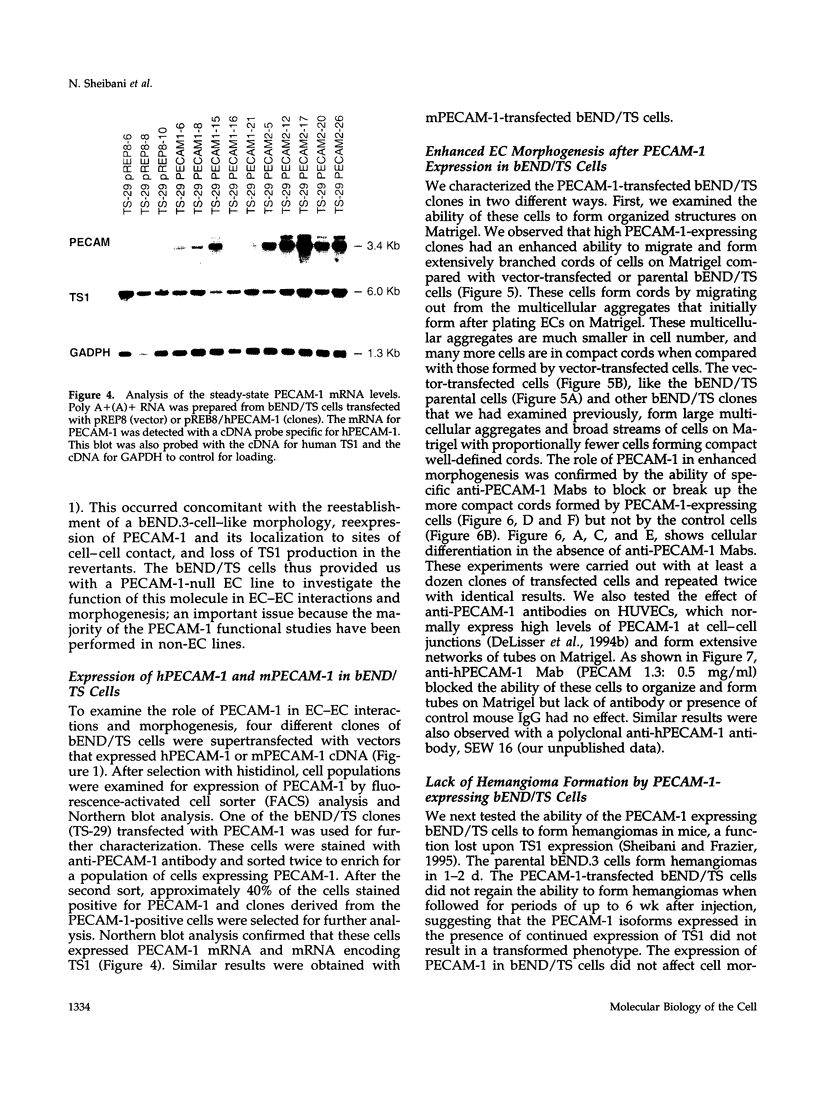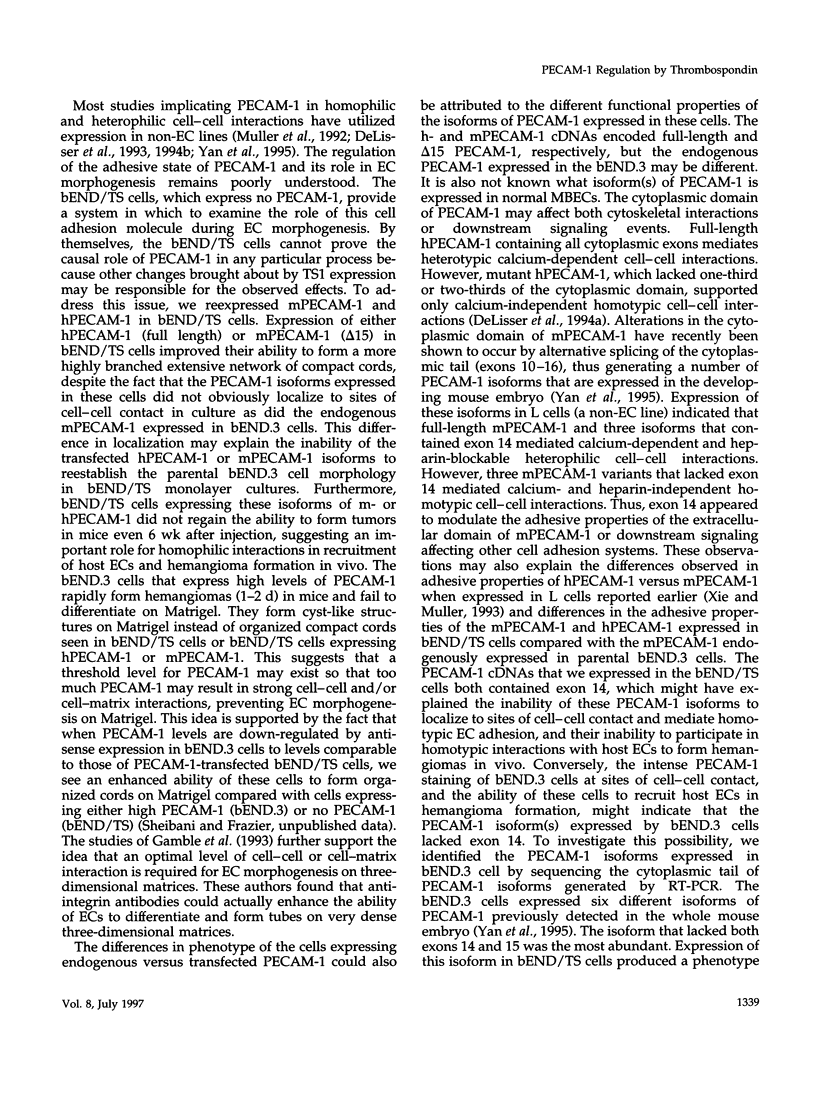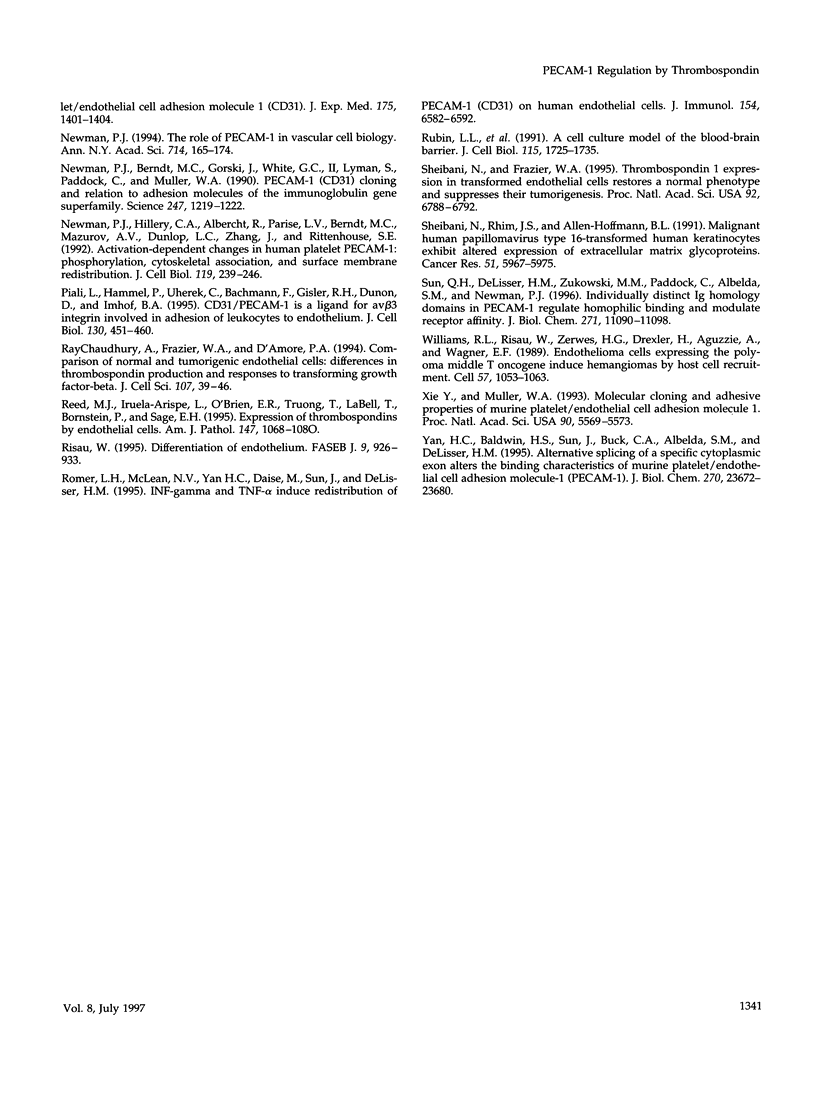Abstract
Expression of thrombospondin-1 (TS1) in polyoma middle-sized T (tumor)-transformed mouse brain endothelial cells (bEND.3) restores a normal phenotype and suppresses their ability to form hemangiomas in mice. We show that TS1 expression results in complete suppression of platelet-endothelial cell adhesion molecule-1 (PECAM-1) expression and altered cell-cell interactions in bEND.3 cells. To further investigate the role of PECAM-1 in regulation of endothelial cell-cell interactions and morphogenesis, we expressed human (full length) or murine (delta 15) PECAM-1 isoforms in TS1-transfected bEND.3 (bEND/TS) cells. Expression of either human or murine PECAM-1 resulted in an enhanced ability to organize and form networks of cords on Matrigel, an effect that was specifically blocked by antibodies to PECAM-1. Anti-PECAM-1 antibodies also inhibited tube formation in Matrigel by normal human umbilical vein endothelial cells. However, PECAM-1-transfected bEND/TS cells did not regain the ability to form hemangiomas in mice and the expressed PECAM-1, unlike the endogenous PECAM-1 expressed in bEND.3 cells, failed to localize to sites of cell-cell contact. This may be, in part, attributed to the different isoforms of PECAM-1 expressed in bEND.3 cells. Using reverse transcription-polymerase chain reaction, we determined that bEND.3 cells express mRNA encoding six different PECAM-1 isoforms, the isoform lacking both exons 14 and 15 (delta 14&15) being most abundant. Expression of the murine delta 14&15 PECAM-1 isoform in bEND/TS cells resulted in a similar phenotype to that described for the full-length human or murine delta 15 PECAM-1 isoform. The delta 14&15 isoform, despite the lack of exon 14, failed to localize to sites of cell-cell contact even in clones that expressed it at very high levels. Thus, contrary to recent reports, lack of exon 14 is not sufficient to result in junctional localization of PECAM-1 isoforms in bEND/TS cells.
Full text
PDF












Images in this article
Selected References
These references are in PubMed. This may not be the complete list of references from this article.
- Albelda S. M., Muller W. A., Buck C. A., Newman P. J. Molecular and cellular properties of PECAM-1 (endoCAM/CD31): a novel vascular cell-cell adhesion molecule. J Cell Biol. 1991 Sep;114(5):1059–1068. doi: 10.1083/jcb.114.5.1059. [DOI] [PMC free article] [PubMed] [Google Scholar]
- Ayalon O., Sabanai H., Lampugnani M. G., Dejana E., Geiger B. Spatial and temporal relationships between cadherins and PECAM-1 in cell-cell junctions of human endothelial cells. J Cell Biol. 1994 Jul;126(1):247–258. doi: 10.1083/jcb.126.1.247. [DOI] [PMC free article] [PubMed] [Google Scholar]
- Baldwin H. S., Shen H. M., Yan H. C., DeLisser H. M., Chung A., Mickanin C., Trask T., Kirschbaum N. E., Newman P. J., Albelda S. M. Platelet endothelial cell adhesion molecule-1 (PECAM-1/CD31): alternatively spliced, functionally distinct isoforms expressed during mammalian cardiovascular development. Development. 1994 Sep;120(9):2539–2553. doi: 10.1242/dev.120.9.2539. [DOI] [PubMed] [Google Scholar]
- Berman M. E., Muller W. A. Ligation of platelet/endothelial cell adhesion molecule 1 (PECAM-1/CD31) on monocytes and neutrophils increases binding capacity of leukocyte CR3 (CD11b/CD18). J Immunol. 1995 Jan 1;154(1):299–307. [PubMed] [Google Scholar]
- Bischoff J. Approaches to studying cell adhesion molecules in angiogenesis. Trends Cell Biol. 1995 Feb;5(2):69–74. doi: 10.1016/s0962-8924(00)88949-7. [DOI] [PubMed] [Google Scholar]
- Bogen S. A., Baldwin H. S., Watkins S. C., Albelda S. M., Abbas A. K. Association of murine CD31 with transmigrating lymphocytes following antigenic stimulation. Am J Pathol. 1992 Oct;141(4):843–854. [PMC free article] [PubMed] [Google Scholar]
- Brooks P. C., Clark R. A., Cheresh D. A. Requirement of vascular integrin alpha v beta 3 for angiogenesis. Science. 1994 Apr 22;264(5158):569–571. doi: 10.1126/science.7512751. [DOI] [PubMed] [Google Scholar]
- Buckley C. D., Doyonnas R., Newton J. P., Blystone S. D., Brown E. J., Watt S. M., Simmons D. L. Identification of alpha v beta 3 as a heterotypic ligand for CD31/PECAM-1. J Cell Sci. 1996 Feb;109(Pt 2):437–445. doi: 10.1242/jcs.109.2.437. [DOI] [PubMed] [Google Scholar]
- Cooper D., Lindberg F. P., Gamble J. R., Brown E. J., Vadas M. A. Transendothelial migration of neutrophils involves integrin-associated protein (CD47). Proc Natl Acad Sci U S A. 1995 Apr 25;92(9):3978–3982. doi: 10.1073/pnas.92.9.3978. [DOI] [PMC free article] [PubMed] [Google Scholar]
- Damsky C., Sutherland A., Fisher S. Extracellular matrix 5: adhesive interactions in early mammalian embryogenesis, implantation, and placentation. FASEB J. 1993 Nov;7(14):1320–1329. doi: 10.1096/fasebj.7.14.8224605. [DOI] [PubMed] [Google Scholar]
- DeLisser H. M., Chilkotowsky J., Yan H. C., Daise M. L., Buck C. A., Albelda S. M. Deletions in the cytoplasmic domain of platelet-endothelial cell adhesion molecule-1 (PECAM-1, CD31) result in changes in ligand binding properties. J Cell Biol. 1994 Jan;124(1-2):195–203. doi: 10.1083/jcb.124.1.195. [DOI] [PMC free article] [PubMed] [Google Scholar]
- DeLisser H. M., Newman P. J., Albelda S. M. Molecular and functional aspects of PECAM-1/CD31. Immunol Today. 1994 Oct;15(10):490–495. doi: 10.1016/0167-5699(94)90195-3. [DOI] [PubMed] [Google Scholar]
- DeLisser H. M., Yan H. C., Newman P. J., Muller W. A., Buck C. A., Albelda S. M. Platelet/endothelial cell adhesion molecule-1 (CD31)-mediated cellular aggregation involves cell surface glycosaminoglycans. J Biol Chem. 1993 Jul 25;268(21):16037–16046. [PubMed] [Google Scholar]
- Drake C. J., Davis L. A., Little C. D. Antibodies to beta 1-integrins cause alterations of aortic vasculogenesis, in vivo. Dev Dyn. 1992 Jan;193(1):83–91. doi: 10.1002/aja.1001930111. [DOI] [PubMed] [Google Scholar]
- Gamble J. R., Matthias L. J., Meyer G., Kaur P., Russ G., Faull R., Berndt M. C., Vadas M. A. Regulation of in vitro capillary tube formation by anti-integrin antibodies. J Cell Biol. 1993 May;121(4):931–943. doi: 10.1083/jcb.121.4.931. [DOI] [PMC free article] [PubMed] [Google Scholar]
- Gao A. G., Lindberg F. P., Finn M. B., Blystone S. D., Brown E. J., Frazier W. A. Integrin-associated protein is a receptor for the C-terminal domain of thrombospondin. J Biol Chem. 1996 Jan 5;271(1):21–24. doi: 10.1074/jbc.271.1.21. [DOI] [PubMed] [Google Scholar]
- Horak E. R., Leek R., Klenk N., LeJeune S., Smith K., Stuart N., Greenall M., Stepniewska K., Harris A. L. Angiogenesis, assessed by platelet/endothelial cell adhesion molecule antibodies, as indicator of node metastases and survival in breast cancer. Lancet. 1992 Nov 7;340(8828):1120–1124. doi: 10.1016/0140-6736(92)93150-l. [DOI] [PubMed] [Google Scholar]
- Kirschbaum N. E., Gumina R. J., Newman P. J. Organization of the gene for human platelet/endothelial cell adhesion molecule-1 shows alternatively spliced isoforms and a functionally complex cytoplasmic domain. Blood. 1994 Dec 15;84(12):4028–4037. [PubMed] [Google Scholar]
- Montesano R., Pepper M. S., Möhle-Steinlein U., Risau W., Wagner E. F., Orci L. Increased proteolytic activity is responsible for the aberrant morphogenetic behavior of endothelial cells expressing the middle T oncogene. Cell. 1990 Aug 10;62(3):435–445. doi: 10.1016/0092-8674(90)90009-4. [DOI] [PubMed] [Google Scholar]
- Muller W. A., Berman M. E., Newman P. J., DeLisser H. M., Albelda S. M. A heterophilic adhesion mechanism for platelet/endothelial cell adhesion molecule 1 (CD31). J Exp Med. 1992 May 1;175(5):1401–1404. doi: 10.1084/jem.175.5.1401. [DOI] [PMC free article] [PubMed] [Google Scholar]
- Muller W. A. The role of PECAM-1 (CD31) in leukocyte emigration: studies in vitro and in vivo. J Leukoc Biol. 1995 Apr;57(4):523–528. doi: 10.1002/jlb.57.4.523. [DOI] [PubMed] [Google Scholar]
- Newman P. J., Berndt M. C., Gorski J., White G. C., 2nd, Lyman S., Paddock C., Muller W. A. PECAM-1 (CD31) cloning and relation to adhesion molecules of the immunoglobulin gene superfamily. Science. 1990 Mar 9;247(4947):1219–1222. doi: 10.1126/science.1690453. [DOI] [PubMed] [Google Scholar]
- Newman P. J., Hillery C. A., Albrecht R., Parise L. V., Berndt M. C., Mazurov A. V., Dunlop L. C., Zhang J., Rittenhouse S. E. Activation-dependent changes in human platelet PECAM-1: phosphorylation, cytoskeletal association, and surface membrane redistribution. J Cell Biol. 1992 Oct;119(1):239–246. doi: 10.1083/jcb.119.1.239. [DOI] [PMC free article] [PubMed] [Google Scholar]
- Newman P. J. The role of PECAM-1 in vascular cell biology. Ann N Y Acad Sci. 1994 Apr 18;714:165–174. doi: 10.1111/j.1749-6632.1994.tb12041.x. [DOI] [PubMed] [Google Scholar]
- Piali L., Hammel P., Uherek C., Bachmann F., Gisler R. H., Dunon D., Imhof B. A. CD31/PECAM-1 is a ligand for alpha v beta 3 integrin involved in adhesion of leukocytes to endothelium. J Cell Biol. 1995 Jul;130(2):451–460. doi: 10.1083/jcb.130.2.451. [DOI] [PMC free article] [PubMed] [Google Scholar]
- RayChaudhury A., Frazier W. A., D'Amore P. A. Comparison of normal and tumorigenic endothelial cells: differences in thrombospondin production and responses to transforming growth factor-beta. J Cell Sci. 1994 Jan;107(Pt 1):39–46. doi: 10.1242/jcs.107.1.39. [DOI] [PubMed] [Google Scholar]
- Reed M. J., Iruela-Arispe L., O'Brien E. R., Truong T., LaBell T., Bornstein P., Sage E. H. Expression of thrombospondins by endothelial cells. Injury is correlated with TSP-1. Am J Pathol. 1995 Oct;147(4):1068–1080. [PMC free article] [PubMed] [Google Scholar]
- Risau W. Differentiation of endothelium. FASEB J. 1995 Jul;9(10):926–933. [PubMed] [Google Scholar]
- Romer L. H., McLean N. V., Yan H. C., Daise M., Sun J., DeLisser H. M. IFN-gamma and TNF-alpha induce redistribution of PECAM-1 (CD31) on human endothelial cells. J Immunol. 1995 Jun 15;154(12):6582–6592. [PubMed] [Google Scholar]
- Rubin L. L., Hall D. E., Porter S., Barbu K., Cannon C., Horner H. C., Janatpour M., Liaw C. W., Manning K., Morales J. A cell culture model of the blood-brain barrier. J Cell Biol. 1991 Dec;115(6):1725–1735. doi: 10.1083/jcb.115.6.1725. [DOI] [PMC free article] [PubMed] [Google Scholar]
- Sheibani N., Frazier W. A. Thrombospondin 1 expression in transformed endothelial cells restores a normal phenotype and suppresses their tumorigenesis. Proc Natl Acad Sci U S A. 1995 Jul 18;92(15):6788–6792. doi: 10.1073/pnas.92.15.6788. [DOI] [PMC free article] [PubMed] [Google Scholar]
- Sheibani N., Rhim J. S., Allen-Hoffmann B. L. Malignant human papillomavirus type 16-transformed human keratinocytes exhibit altered expression of extracellular matrix glycoproteins. Cancer Res. 1991 Nov 1;51(21):5967–5975. [PubMed] [Google Scholar]
- Sun Q. H., DeLisser H. M., Zukowski M. M., Paddock C., Albelda S. M., Newman P. J. Individually distinct Ig homology domains in PECAM-1 regulate homophilic binding and modulate receptor affinity. J Biol Chem. 1996 May 10;271(19):11090–11098. doi: 10.1074/jbc.271.19.11090. [DOI] [PubMed] [Google Scholar]
- Williams R. L., Risau W., Zerwes H. G., Drexler H., Aguzzi A., Wagner E. F. Endothelioma cells expressing the polyoma middle T oncogene induce hemangiomas by host cell recruitment. Cell. 1989 Jun 16;57(6):1053–1063. doi: 10.1016/0092-8674(89)90343-7. [DOI] [PubMed] [Google Scholar]
- Xie Y., Muller W. A. Molecular cloning and adhesive properties of murine platelet/endothelial cell adhesion molecule 1. Proc Natl Acad Sci U S A. 1993 Jun 15;90(12):5569–5573. doi: 10.1073/pnas.90.12.5569. [DOI] [PMC free article] [PubMed] [Google Scholar]
- Yan H. C., Baldwin H. S., Sun J., Buck C. A., Albelda S. M., DeLisser H. M. Alternative splicing of a specific cytoplasmic exon alters the binding characteristics of murine platelet/endothelial cell adhesion molecule-1 (PECAM-1). J Biol Chem. 1995 Oct 6;270(40):23672–23680. doi: 10.1074/jbc.270.40.23672. [DOI] [PubMed] [Google Scholar]









